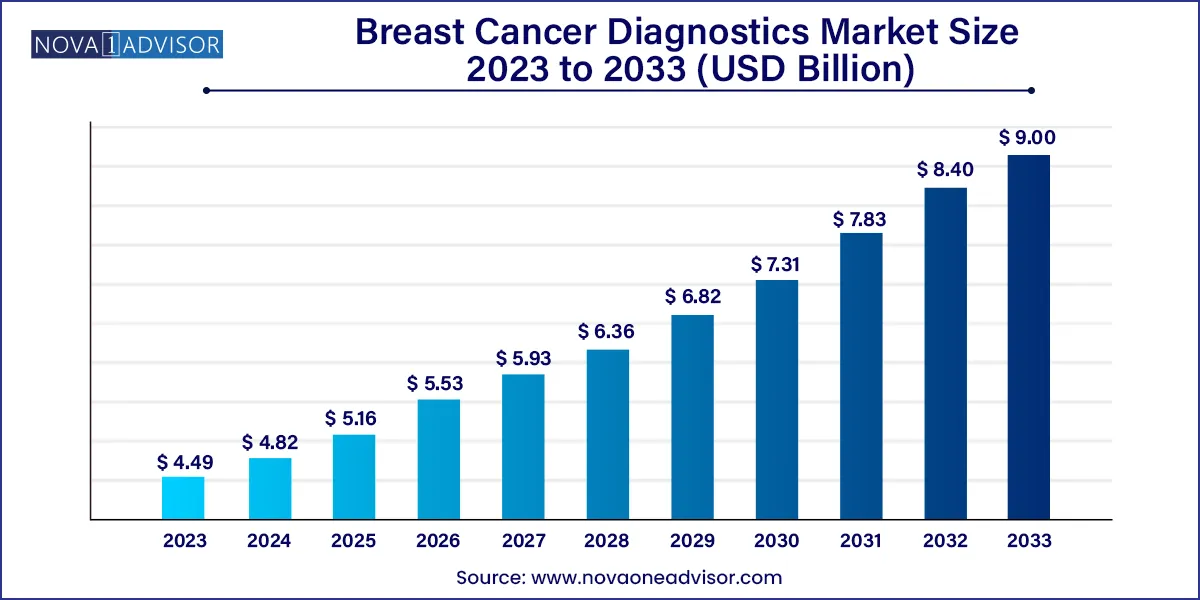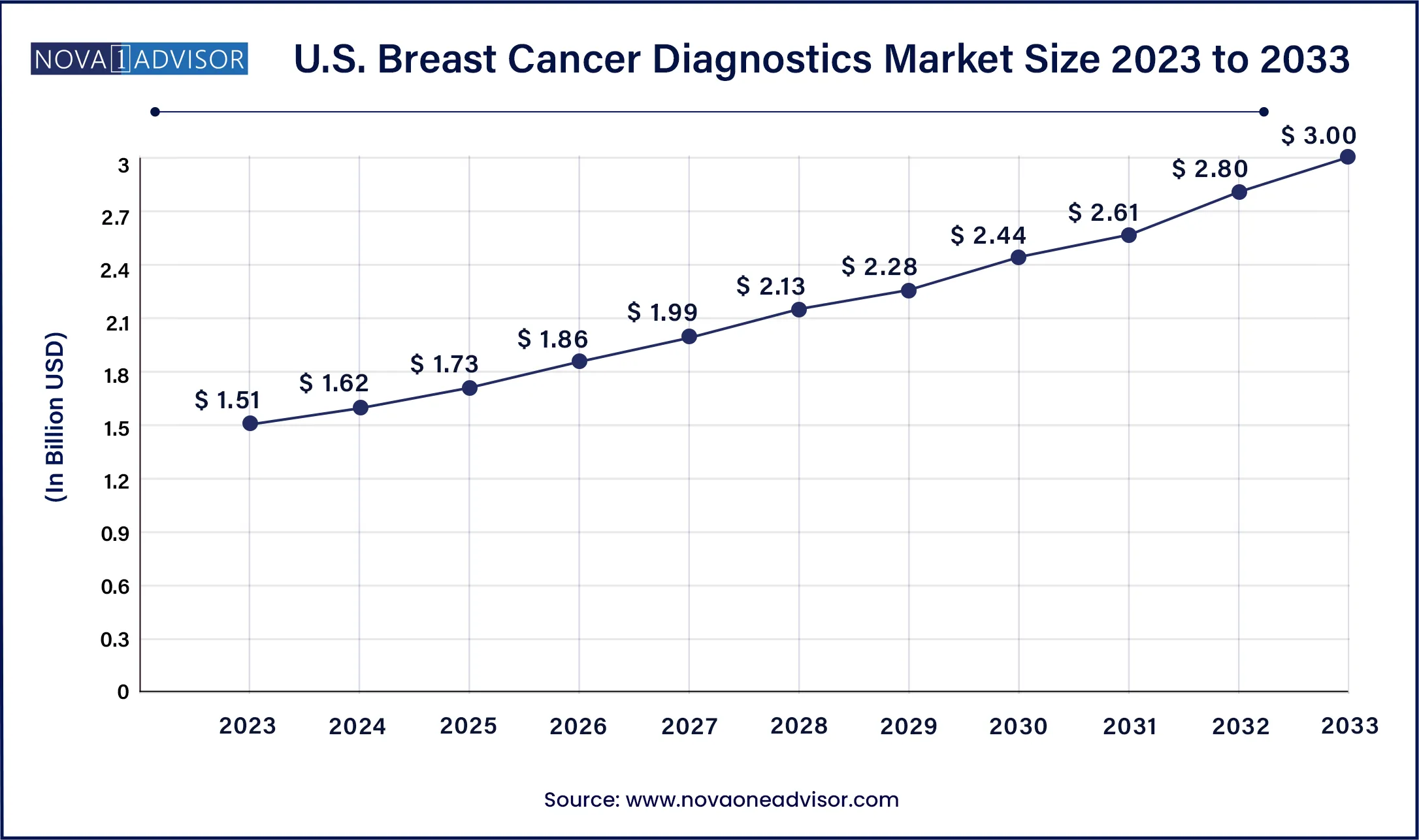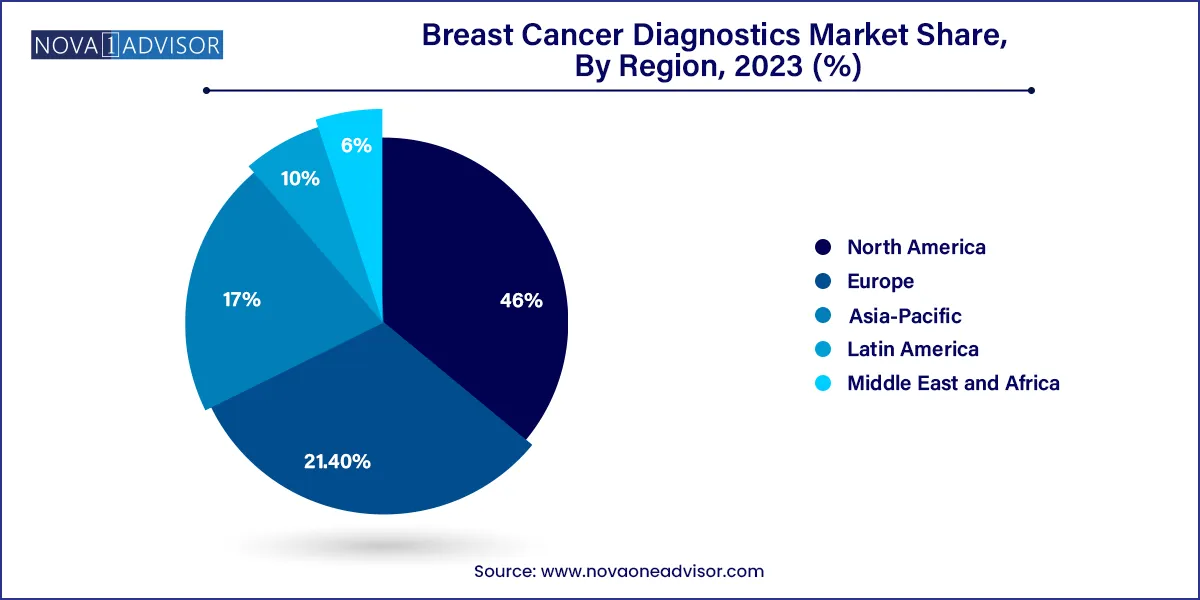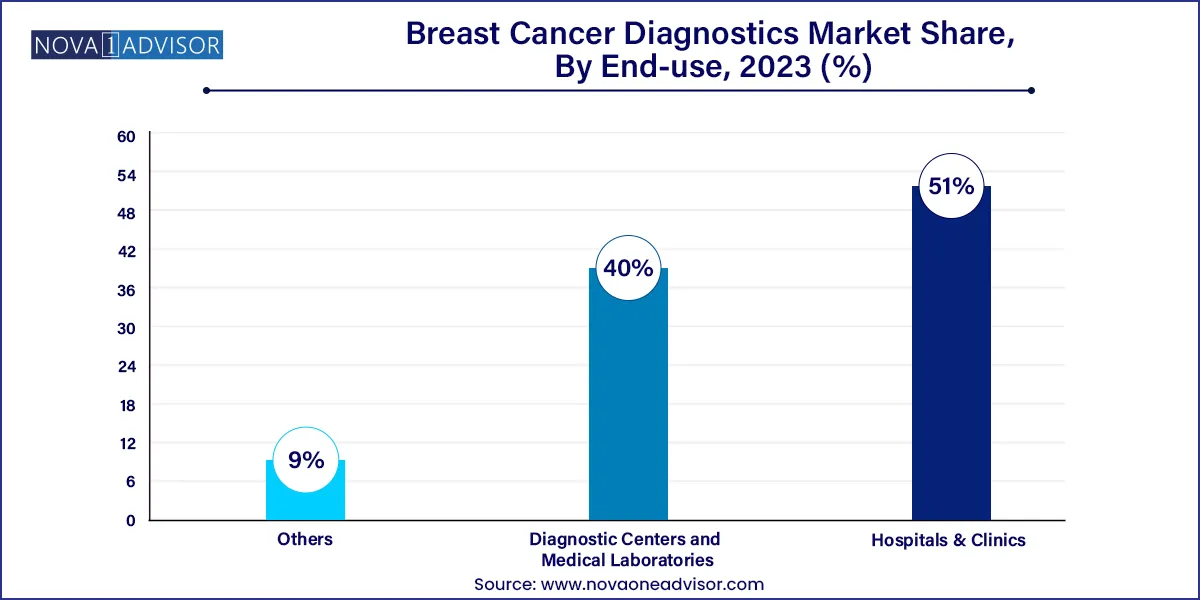The global breast cancer diagnostics market size was estimated at USD 4.49 billion in 2023 and is projected to hit around USD 9.00 billion by 2033, growing at a CAGR of 7.2% during the forecast period from 2024 to 2033.

Key Takeaways:
- North America dominated the market with a revenue share of 46.00% in terms of revenue in 2023.
- The imaging segment dominated the overall market with a revenue share of 53.74% in 2023.
- The blood test segment is anticipated to grow at the fastest growth rate over the forecast period with a CAGR of 9.9%
- The instrument-based products segment dominated the overall market with a revenue share of 72.18% in 2023.
- The platform-based products segment is anticipated to grow at a CAGR of 9.3% over the forecast period.
- The diagnostic & predictive segment dominated the overall market with a revenue share of 49.4% in 2023.
- The prognostic segment is expected to grow at a CAGR of 8.4% over the forecast period.
- The hospitals & clinics segment dominated the overall market with a revenue share of 51.00% in 2023.
- The medical labs & diagnostics centers segment is anticipated to grow at the fastest growth rate over the forecast period with a CAGR of 8.2%.
Breast Cancer Diagnostics Market Size in the U.S. 2023 to 2032
The U.S. Breast Cancer Diagnostics market size was valued at USD 1.51 billion in 2023 and is anticipated to reach around USD 3 billion by 2033, growing at a CAGR of 7.1% from 2024 to 2033.

North America, particularly the United States, dominates the breast cancer diagnostics market due to its well-established healthcare infrastructure, high awareness levels, and widespread adoption of advanced technologies. The U.S. records one of the highest rates of routine mammography usage, supported by insurance coverage and public health initiatives. Major players like Hologic and GE Healthcare are headquartered in the region, leading global innovation in imaging and diagnostic tools. Furthermore, the region is a leader in the adoption of genomic testing, with Medicare and private insurers increasingly covering tests like Oncotype DX, enabling clinicians to personalize treatment plans effectively.

Asia-Pacific is the fastest-growing region in the breast cancer diagnostics market, driven by rising cancer incidence, increased healthcare spending, and improved diagnostic awareness. Countries like China, India, and South Korea are expanding breast cancer screening programs and investing in healthcare infrastructure. Japan has also adopted digital mammography and tomosynthesis at a significant pace. Additionally, the growth of private diagnostic chains and mobile screening units in rural areas is helping bridge access gaps. As regulatory frameworks evolve to accommodate personalized medicine and genomic testing, APAC is poised for rapid diagnostic market expansion.
Market Overview
The global Breast Cancer Diagnostics Market stands as a cornerstone of the broader oncology diagnostics landscape, providing critical tools for the early detection, accurate diagnosis, and effective treatment planning of one of the most prevalent cancers worldwide. Breast cancer is the most diagnosed cancer globally, surpassing lung cancer in recent years. In 2025, it is projected that over 2.3 million new cases will be reported worldwide, with mortality rates remaining significant despite advances in therapeutics. This scenario underscores the pivotal role of timely and reliable diagnostics in improving patient survival and reducing the burden on healthcare systems.
Diagnostics in breast cancer encompass a wide array of methodologies ranging from imaging technologies such as mammography, ultrasound, and MRI to molecular tests like PCR, genomic profiling, and liquid biopsies. The market has evolved from reliance solely on anatomical imaging to an integrated approach that includes biomarker analysis, AI-assisted image interpretation, and genetic risk assessments. These advancements enable oncologists to stratify risk, predict response to therapies, and customize treatment regimens, thereby enhancing clinical outcomes.
Governments and healthcare agencies across the globe, including the World Health Organization (WHO), have initiated awareness campaigns, mandatory screening programs, and funding grants that are directly fueling the growth of breast cancer diagnostics. Simultaneously, rising public health awareness, an aging female population, and increasing adoption of precision medicine are adding momentum to the market. Industry players such as Hologic, Roche Diagnostics, GE Healthcare, Siemens Healthineers, and Guardant Health are leading innovations that are setting new standards in sensitivity, specificity, and accessibility.
Major Trends in the Market
-
Shift Toward Non-Invasive Liquid Biopsy Technologies: Liquid biopsies are emerging as a promising complement to tissue biopsies, offering real-time monitoring with minimal patient discomfort.
-
AI Integration in Imaging and Workflow Automation: Artificial intelligence is being deployed to assist radiologists in image analysis, reduce false positives, and improve diagnostic throughput.
-
Expansion of Genomic and Multigene Assays: Tests like Oncotype DX and MammaPrint are being used for therapy decision-making, especially in hormone receptor-positive breast cancers.
-
Digital Pathology Adoption: With digitized slide imaging and AI-based interpretation, pathology labs are enhancing diagnostic accuracy and efficiency.
-
Point-of-Care Diagnostics and Home-Based Testing: Miniaturized, rapid-testing solutions are emerging for early screening and BRCA mutation testing.
-
Personalized Prognostics with AI and Biomarker Panels: Biomarker integration for HER2, ER, PR, and Ki-67 with AI-driven algorithms is improving treatment precision.
-
Increasing Global Screening Programs: Governments are expanding mandatory breast screening in both developed and emerging economies, driving volume and innovation.
-
Growth in Cloud-Based Diagnostic Platforms: Teleradiology and data sharing platforms are improving diagnostic collaboration and access in remote regions.
Breast Cancer Diagnostics Market Report Scope
| Report Attribute |
Details |
| Market Size in 2024 |
USD 4.82 Billion |
| Market Size by 2033 |
USD 9.00 Billion |
| Growth Rate From 2024 to 2033 |
CAGR of 7.2% |
| Base Year |
2023 |
| Forecast Period |
2024 to 2033 |
| Segments Covered |
Type, product, application, end-use, region |
| Market Analysis (Terms Used) |
Value (US$ Million/Billion) or (Volume/Units) |
| Report Coverage |
Revenue forecast, company ranking, competitive landscape, growth factors, and trends |
| Key Companies Profiled |
Hologic Inc.; Genomic Health (Exact Sciences Corporation); BD; Danaher; Koninklijke Philips N.V.; QIAGEN; Thermo Fisher Scientific Inc.; Myriad Genetics, Inc.; Argon Medical Devices, Inc.; F. Hoffmann-La Roche Ltd. |
Market Driver: Increasing Incidence of Breast Cancer and Early Screening Awareness
A major driver fueling the growth of the breast cancer diagnostics market is the rising incidence of breast cancer coupled with increasing awareness about the importance of early screening. In the United States alone, the American Cancer Society projects approximately 300,000 new cases of invasive breast cancer in women for 2025. Early detection remains one of the most effective strategies for improving survival rates, reducing the extent of treatment, and lowering healthcare costs. Diagnostic solutions that detect cancer at stages 0 or I have significantly improved patient outcomes, with five-year survival rates exceeding 90% for early-stage detection.
Governments and health organizations worldwide are implementing large-scale awareness campaigns and subsidizing mammography and other screening programs. For instance, the U.K.'s NHS Breast Screening Programme offers free mammograms to women aged 50 to 70, while the U.S. Preventive Services Task Force recommends biennial screening for women aged 40 to 74. These initiatives, along with corporate wellness programs and non-profit efforts, are driving demand for diagnostic tools that are faster, safer, and more accurate.
Market Restraint: High Cost and Accessibility Limitations in Low-Resource Settings
Despite strong growth potential, one of the primary restraints in the breast cancer diagnostics market is the high cost of advanced diagnostic modalities and limited access in low-income and underserved regions. Technologies such as 3D mammography, MRI, genomic sequencing, and AI-driven imaging tools require substantial investment in equipment, maintenance, and skilled personnel. This poses a challenge for rural clinics, community hospitals, and healthcare systems in developing countries.
Moreover, personalized diagnostic tools like multigene assays or liquid biopsies can be prohibitively expensive for uninsured or underinsured populations, even in developed nations. The result is delayed diagnosis, missed screenings, and higher mortality in lower-income demographics. Although mobile mammography vans and telehealth-based image interpretation have started to address this gap, affordability and equitable access remain persistent challenges that require innovative and policy-driven solutions.
Market Opportunity: Expansion of Genomic Testing and Precision Oncology
The rapid advancement of genomic testing technologies presents a substantial opportunity within the breast cancer diagnostics market. As precision oncology gains traction, tests that reveal the molecular and genetic characteristics of tumors are becoming essential for tailoring treatments. Genomic assays such as Oncotype DX, MammaPrint, and FoundationOne CDx analyze gene expression profiles to predict chemotherapy benefits, recurrence risk, and targeted therapy eligibility.
These tests are increasingly reimbursed by insurance providers in the U.S., Europe, and select Asia-Pacific markets, paving the way for broader clinical adoption. Additionally, partnerships between diagnostic firms and pharmaceutical companies are accelerating the development of companion diagnostics that are critical for the success of targeted therapies like HER2 inhibitors and CDK4/6 inhibitors. As more BRCA and PALB2 mutation-targeting therapies enter clinical use, demand for genomic testing is expected to rise sharply, creating new avenues for revenue growth and market expansion.
By Type Insights
Imaging led the diagnostic types segment, accounting for the largest market share due to its routine use in breast cancer screening and surveillance. Mammography remains the gold standard for early detection, with digital breast tomosynthesis (3D mammography) offering enhanced sensitivity in dense breast tissues. Ultrasound and MRI are also widely used as supplementary tools, especially in high-risk patients. Imaging’s dominance is reinforced by its accessibility, lower cost relative to genomic tests, and widespread inclusion in national screening programs.
Genomic tests are the fastest-growing segment, driven by the shift toward personalized medicine. Tests such as Oncotype DX and MammaPrint provide actionable information about tumor biology, helping to inform decisions about adjuvant chemotherapy and endocrine therapy. The inclusion of these assays in clinical guidelines by organizations like ASCO and NCCN is accelerating their uptake. Furthermore, as next-generation sequencing becomes more affordable, comprehensive molecular profiling of breast tumors is expected to become routine in clinical oncology.
By Product Insights
Instrument-based products dominated the product segment, especially imaging and biopsy instruments that are integral to the diagnostic workflow. Advanced diagnostic imaging platforms from GE Healthcare, Siemens, and Hologic are widely used in hospitals and diagnostic centers, offering reliable breast density measurement and lesion detection capabilities. Biopsy devices—both stereotactic and ultrasound-guided are essential for definitive cancer diagnosis.
Platform-based products are growing fastest, particularly those based on next-generation sequencing (NGS) and PCR. These tools are crucial for conducting gene panel tests, detecting hereditary cancer risks, and identifying therapeutic targets. With the rise of liquid biopsy technologies, platform-based systems are expanding beyond labs into hospital-based oncology departments, driving demand for compact, fast, and automated platforms.
By Application Insights
Screening applications led the segment, fueled by public health campaigns and mandatory screening recommendations. Regular screening allows for early detection before clinical symptoms appear, thereby improving prognosis. Mammography is the cornerstone of screening, often performed annually or biennially, contributing to a large volume of diagnostic procedures globally.
Prognostic applications are the fastest-growing, as oncologists increasingly rely on molecular data to predict outcomes and guide treatment decisions. Gene expression tests that evaluate recurrence risk and likely therapy response are becoming indispensable in managing hormone receptor-positive, HER2-negative breast cancers. The integration of AI into prognostic modeling using data from imaging, histopathology, and genomics further boosts this segment’s growth.
By End-use Insights
Hospitals and clinics dominate the end-use segment, as they are the primary points of care for breast cancer diagnosis, staging, and treatment planning. Large hospitals have the capacity to conduct imaging, biopsy, and genomic analysis under one roof, ensuring quick turnaround and streamlined care coordination. The integration of electronic health records with diagnostic platforms also supports efficient data interpretation and decision-making.

Diagnostic centers and medical laboratories are growing rapidly, due to the increasing outsourcing of specialized diagnostics. As genomic and liquid biopsy technologies evolve, many clinics and oncology practices rely on high-throughput labs for testing and result interpretation. Companies like Guardant Health and Roche Diagnostics have built scalable infrastructures to support centralized testing, reducing costs and improving access.
Some of the prominent players in the global breast cancer diagnostics market include:
- Genomic Health (Exact Sciences Corporation)
- BD
- Danaher
- Koninklijke Philips N.V.
- QIAGEN
- Thermo Fisher Scientific Inc.
- Myriad Genetics, Inc.
- Argon Medical Devices, Inc.
- F. Hoffmann-La Roche Ltd.
- Hologic Inc.
Segments Covered in the Report
This report forecasts revenue growth at country levels and provides an analysis of the latest industry trends in each of the sub-segments from 2021 to 2033. For this study, Nova one advisor, Inc. has segmented the Breast Cancer Diagnostics market.
By Type
- Imaging
- Biopsy
- Genomic Tests
- Blood Tests
- Others
By Product
- Platform-based Products
- Next-generation Sequencing
- Microarrays
- PCR
- Others
- Instrument-based Products
By Application
- Screening
- Diagnostic and Predictive
- Prognostic
- Research
By End-use
- Hospitals & Clinics
- Diagnostic Centers and Medical Laboratories
- Others
By Region
- North America
- Europe
- Asia-Pacific
- Latin America
- Middle East & Africa (MEA)




